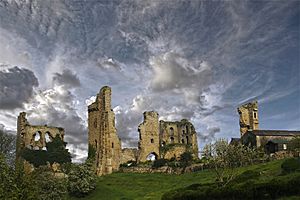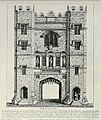Percy–Neville feud facts for kids
The Percy–Neville feud was a big fight between two powerful families in northern England, the House of Percy and the House of Neville. This feud involved small battles, raids, and damage to property. It was one of the main reasons that led to the Wars of the Roses, a series of wars fought over who should be king of England.
The exact reason for this long-lasting dispute isn't fully known. The first signs of violence appeared in the 1450s, even before the main Wars of the Roses began. The two families and their supporters would later face each other in battle several times.
Contents
Why the Feud Started
Northern England, especially Yorkshire, was divided among powerful groups. These included the King, the Duke of York, the Percy family, and the Neville family. The King and the Duke of York didn't visit Yorkshire very often. This meant that any problems in the area were usually between the Percys and the Nevilles.
The city of York was very important. It became a central place for their rivalry. It's no surprise that two major clashes between the Percys and Nevilles in 1453 and 1454 happened near York. People who lived on Percy lands might have disliked the Nevilles as much as their lords did. This was because their lands were next to each other, which could easily cause problems.
Experts believe that by the mid-1400s, the relationship between the Percys and Nevilles was filled with jealousy and anger. It seems the Earl of Northumberland (a Percy) felt he was getting less favor from the King than the Earl of Salisbury (a Neville). When the trouble really started, it was the sons of these powerful earls who began the fighting, not the earls themselves.
What Caused the First Fights
Several things led to the violence starting in 1454. One big reason was a marriage in 1453. Thomas Neville, the second son of the Earl of Salisbury, married Maud Stanhope. Maud was the widow of a rich lord.
This marriage was a problem for the Percys. It meant the Neville family would become even more powerful. Also, Maud's family had connections to lands that used to belong to the Percys, like Wressle and Burwell. These lands had been taken from the Percys after a rebellion in 1403. The Nevilles getting access to these lands made the Percys, especially Lord Egremont, very angry.
The Fight at Heworth Moor
The first real fight between the two families happened on 24 August 1453. This was a direct response to Thomas Neville's marriage. Lord Egremont, a Percy, was especially upset. He gathered many men in York and planned to attack the Nevilles.
The Nevilles were on their way to their castle at Sheriff Hutton Castle. Lord Egremont probably wanted to capture or harm them. However, the Neville family was traveling with their own armed groups. As powerful earls, Salisbury and Warwick (a Neville) could have at least a hundred soldiers each. This meant the Nevilles probably had more men than Egremont expected.
The Percy force was likely larger overall, possibly over a thousand men. But both sides were afraid of a full-scale battle. So, there wasn't much bloodshed. The Nevilles were able to quickly retreat to their strong castle at Sheriff Hutton.
Other Incidents
After the fight at Heworth Moor, the conflict grew more intense.
- October 20, 1453: The leaders of both sides gathered their forces. Thomas and John Neville (for the Nevilles) went to Topcliffe. Lord Egremont and Sir Richard Percy (for the Percys) went to Sand Hutton. Their fathers and older brothers also joined them. What happened during this standoff isn't fully known.
- May 6, 1454: Salisbury's house in York was broken into, and his tenants (people living on his land) were attacked. Many of the attackers had been with Lord Egremont at Heworth Moor.
The King Tries to Help
The King and his council tried to stop the fighting. In July 1453, they set up a special group to investigate the problems. However, this group didn't work well. It was too small, and some of its members were loyal to the Nevilles. This made the Percys feel that the King couldn't or wouldn't be fair.
By the end of July, the situation in the north was so bad that the King basically told the two earls to fix it themselves. He told them to control their sons. The King's council also wrote to the Earl of Westmorland (a Neville) and thanked him for not joining the feud. They also wrote to Salisbury and Northumberland, reminding them of their duty to keep the peace.
Parliament also demanded that the nobles solve their problems peacefully. But the King's letters showed that both families kept raising armed forces despite these pleas. The younger sons involved in the feud received stronger warnings, being told they could lose their lands. The King was sick at this time, which made it harder for the government to stop the fighting.
Open Warfare and Battles
The fighting continued. Sir John Neville attacked and damaged the absent Earl of Northumberland's house at Catton. The next day, Richard Percy attacked a Neville property.
The danger of a civil war grew when both sides called their supporters to their strongholds in the north. On October 20, the Percy family had gathered 10,000 men at Topcliffe. Just four miles away, the Neville force was at Sheriff Hutton. After several threats from the King, both sides agreed to a truce and sent their men home. But, as one writer said, "There was no reconciliation, the day of reckoning had merely been postponed."
Despite these efforts, a few hundred men likely clashed at Stamford Bridge around October 31 or November 1, 1454. Hundreds were killed or wounded. Lord Egremont was captured by John Neville and imprisoned.
York's Time in Power
The Nevilles became allies with Richard, Duke of York. They had common enemies, like the King's chief minister. This alliance became very important for the whole country.
When the King became mentally ill, the Duke of York was made the "Protector" (meaning he ruled for the King), and Salisbury (a Neville) became the Chancellor. This gave Salisbury a chance to get back at the Percys. Salisbury was now in a powerful position to threaten Lord Egremont and his father much more strongly than the King's council had before.
Later, when the King recovered, York lost his power. The Percys had suffered a lot during York's time in charge. The King's chief minister, who had been imprisoned, was released and quickly allied with the Percys.
Six months later, King Henry VI, his chief minister, and the Percys (who supported the Lancastrian side) met the Duke of York and the Nevilles (who supported the Yorkists side) in the First Battle of St Albans. In this battle, the chief minister and the Earl of Northumberland were killed.
The Battle of Stamford Bridge
Stamford Bridge was a Neville property east of York. On October 31, 1454, Lord Egremont and then Richard Percy were captured by Sir Thomas Neville. Many people were killed and wounded in this fight. The Neville victory was likely helped by a Percy official who switched sides. The two Percy brothers were taken to Middleham Castle and then handed over to the Duke of York.
What Happened Next
After their defeat at Stamford Bridge, the Percy brothers faced a special court in York. They were ordered to pay huge sums of money. They had to pay 8,000 marks to Salisbury, plus fines to his wife and sons, totaling 16,800 marks. This was Salisbury's way of getting paid for all the damage done to his lands during the feud.
To try and keep the peace, both sides had to agree to financial promises. Salisbury promised the King 12,000 marks for his sons, Thomas and John, who were key Neville players. In return, Northumberland and his mother promised the same amount for any actions against York and the Nevilles. Salisbury also agreed that Lord Egremont would be released from his 16,800-mark fine. Egremont himself then had to promise 4,000 marks. He would have to pay this to Salisbury if he broke the peace with the Neville family for the next ten years. The idea was that these agreements would "wipe the slate clean" and end the feud.
Images for kids







